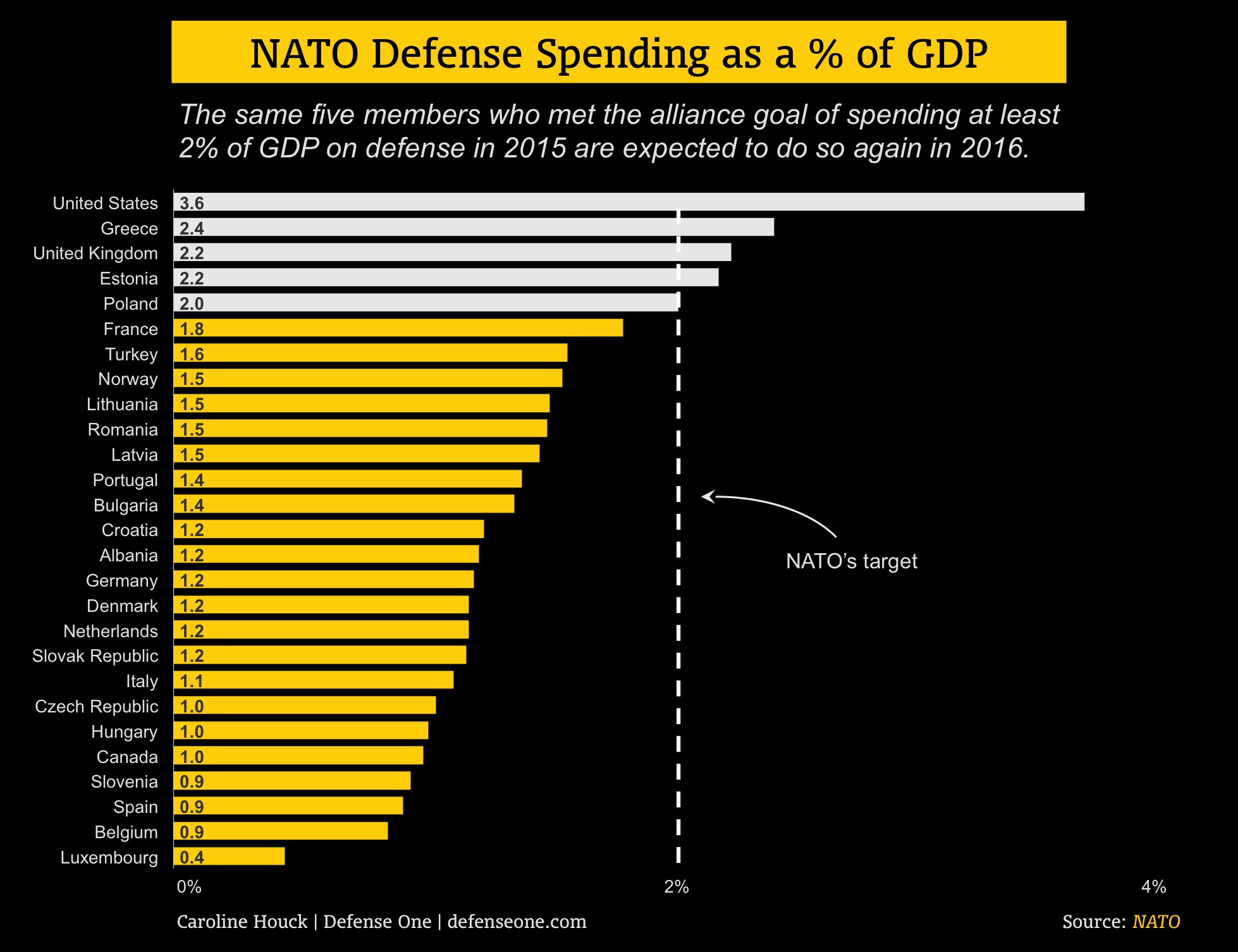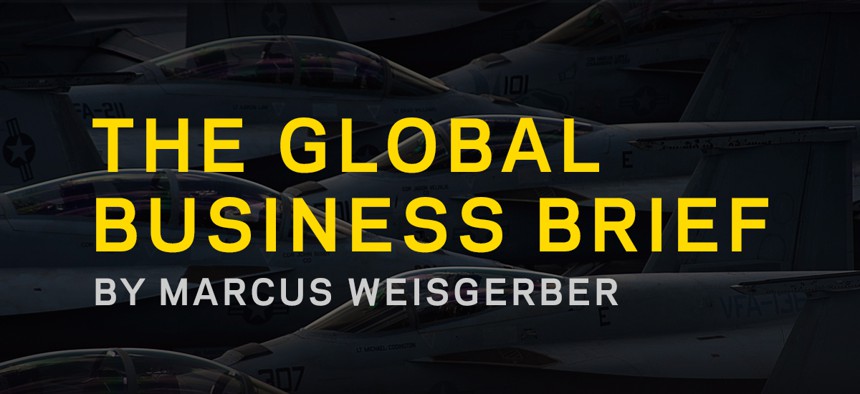A New Path to Foreign Sales; NATO By the Numbers; USAF Budget Shortfalls
Welcome to Vol. 2 of our weekly newsletter about the future of the business of defense.
A New Path to Foreign Sales
The Pentagon starts so few new weapon programs these days, companies that lose the multibillion-dollar initial competitions to supply new guns, aircraft, vehicles, and other weapons are sometimes forced to go looking for new types of business . But a relatively tiny deal struck between the U.S. Air Force and Textron AirLand might give firms some more options — like an easier path to foreign sales.
AirLand had been trying to persuade the Air Force to buy its Scorpion jet, a small, all-composite attack plane that uses many parts common with business jets and other types of commercial aircraft. A purchase would have meant more to the company than U.S. revenue; it would have qualified the aircraft for export help via the Pentagon’s Foreign Military Sales program. But while Air Force officials have remained impervious to AirLand’s sales pitch, they have agreed to a deal in which Textron will pay to have the military test the Scorpion, then (if it passes) certify it as airworthy. Company officials, and at least one observer , believe this seal of approval will boost their plane’s chances in overseas markets.
“We've had … a number of international customers that have been looking at the aircraft,” Scott Donnelly, Textron’s chairman, president and CEO, said in the company’s quarterly earnings call last week. “There really have been two issues for them. One is, how are you going to get this thing certified so that they can provide their certification on top of it. And not unreasonably, customers want to fly the production fully conforming aircraft. We have the accreditation path checked off, and here in the next month or so, we'll be flying the first production configured aircraft.”
This arrangement with the Air Force, formally called a cooperative research and development agreement, is a big deal for American arms makers. In the past, a new plane that lost a military competition was often relegated to a museum. Take the Boeing X-32, which lost to Lockheed Martin’s F-35 in the Joint Strike Fighter program, or Northrop’s YF-23, beaten by the F-22. As one consultant told me, “It was all or nothing.” But this new deal between the Air Force and Textron could change that.
Had such an arrangement been possible, Northrop or Boeing might have taken their unchosen-but-certified aircraft to foreign buyers. And if they kept working on their projects, it would have kept pressure on the companies that won to stay on schedule and budget — and given the Pentagon a backup plan. Now expand that concept beyond planes to tanks, armored vehicles, and other types of weapons.
While such an arrangement might not work for everything — the losing design in the stealth bomber contest is still too highly classified for export — there’s perhaps greater potential for these types of arrangements on smaller projects. The Air Force is already looking beyond Scorpion.
“We have six or seven, perhaps, in the pipeline who are looking for similar arrangements,” Air Force Secretary Deborah Lee James said at my Defense One Leadership Briefing on Tuesday .
The idea for the Scorpion certification appeared during routine discussions between the Air Force and Textron. “It came up that it would be very helpful to have some sort of accreditation from the U.S. government to help with foreign sales,” James said. She called the deal a “win-win” for the Air Force and Textron.
Textron AirLand, QinetiQ, and Thales announced at the the Farnborough Air Show that Scorpion would be part of a joint bid for a British military training program. This will be first test to see if the Air Force certifications play a factor in the British decision.
Welcome. (Subscribe!)
Welcome to the Defense One Global Business Brief by Marcus Weisgerber, your new weekly source for all things about the business of defense. This is Episode II, guaranteed to be better than “ Attack of the Clones ”. Come along as I talk to CEOs and factory workers, generals and sergeants, to suss out what’s next for defense firms and their customers. With eyes on the future, we profile the people and projects that are changing how the Pentagon does business. Send your tips, comments, and random thoughts to mweisgerber@defenseone.com , or hit me up on Twitter: @MarcusReports . Oh, and don’t forget to subscribe .
Who Spends 2%?

Just how much are NATO members spending on their militaries? On Friday, Republican presidential candidate Donald Trump said he would look at members’ contributions to the alliance before defending them from an attack.
NATO recommends that each member of the alliance spend 2 percent of their country’s gross domestic product in defense. Only five countries — the United States, Greece, U.K., Estonia, and Poland — meet that mark. But note: it’s just a recommendation, approved by heads-of-state in 2014. It has nothing to do with the members’ treaty obligation to defend each other if attacked (see: Article V ).
Overall, defense spending by alliance nations (minus the U.S.) spending year-over-year is projected to rise 3 percent in 2016, according to NATO . Defense spending dropped in just four countries: Belgium, Croatia, Greece, and Poland.
While 2-percent-of-GDP tends to get the headlines, NATO has another recommendation for its members, and that’s to spend 20 percent of its defense budget on new equipment. Who spends the most there? Luxembourg, with 32.8 percent — but keep in mind, the country ranks dead last in the GDP rankings with .4 percent of its budget going toward defense.
Where does the U.S. fall on the equipment list? Sixth, at 25 percent, behind Lithuania, Romania, Poland, and Norway. But that’s largely because those other countries don’t have the increasing personnel costs that continue to crowd out other parts of the Pentagon’s budget.
Here are two charts tracking NATO members’ spending as a percentage of GDP by my colleague, Defense One Fellow Caroline Houck :

USAF Readiness, Budget Shortfalls
About half of the U.S. Air Force’s “combat air forces” (the units deployed around the world) are “not sufficiently ready” for a high-end air-to-air war with a “major world competitor,” aka Russia or China, AF Secretary James said. (Watch, here .) On top of that, she said, the Air Force is facing a $1.3 billion shortfall beginning on Oct. 1 if Congress does not pass a budget by the end of fiscal 2016 — and right now, lawmakers are not expected to pass a fiscal 2017 budget until after the presidential election in November. But she had good news as well. “Five years ago, we were still downsizing,” she said. “Now we are growing, in recognition of just how important our Air Force is in every engagement around the world.”
Poland Finalizing Patriot Deal
The long-awaited deal for two Patriot air missile and missile defense systems will reportedly be finalized with Raytheon by the end of the year. There had been talk that Poland might reconsider Lockheed Martin’s Medium Extended Air Defense System, or MEADS, instead of Patriot.
Next Week
- Boom: a big explosive ordnance disposal conference in Bethesda, Md. Expect Army Lt. Gen. Michael Shields, director of the Joint Improvised-Threat Defeat Agency, the group formerly known as JIEDDO, to talk about new tech to counter IEDs.
- Harris, Orbital-ATK and Huntington-Ingalls Industries will report earnings.
Cocktails and Conversation
Join me at the Space and Missile Defense Symposium in Huntsville, Alabama, for Defense One Cocktails and Conversations as we discuss the future of missile defense. We’ll explore the emergence of missile defense as a functioning technology sought by militaries across the world and discuss why battlefield successes and ever-increasing capabilities have made missile defense a growth area for the defense industry. Come have a drink on Aug. 15 with Missile Defense Agency’s Brig. Gen. William Cooley, program executive for programs and integration and other panelists. For the lineup, details, and registration, go here .





